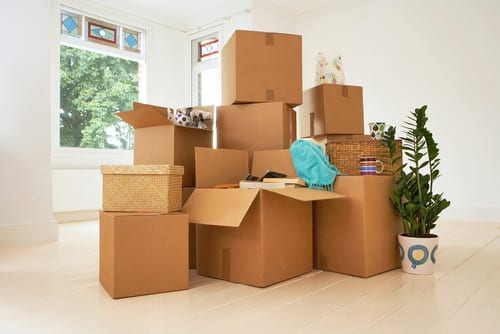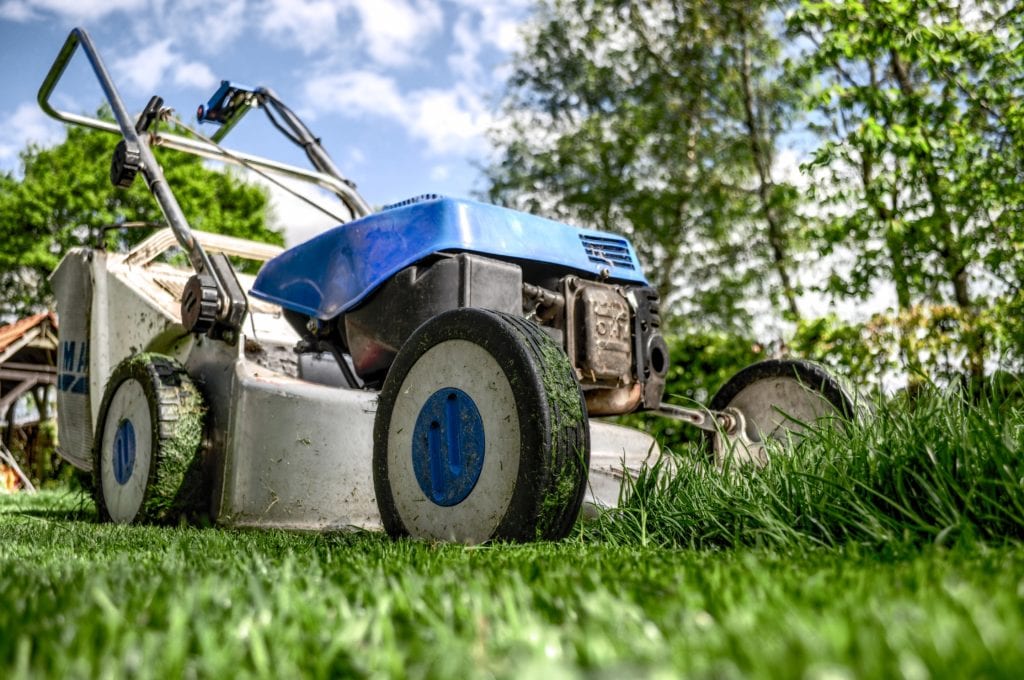
There’s nothing more exciting than finally being able to settle into your new home! Perhaps the least glamorous part of moving in is the actual moving part. Depending on how many belongings you own, moving can be an especially tedious task, not to mention pricey. Let us teach you some tricks on how to save on moving costs.
When it comes to moving, you can never have too many boxes! Don’t spend all your money on new boxes you’ll likely never use again; try asking your friends and neighbors for any empty boxes they may have. With online shopping being so prevalent nowadays, it probably won’t be difficult to find several people willing to give you their empty boxes. Additionally, you can use old newspapers, rags, towels, or clothes to cushion fragile items instead of buying bubble wrap.
Hopefully paring down your possessions has been one task you’ve been working on in preparation for selling your home. You should get rid of items you don’t use or need to reduce how much you’ll have to pack. You can sell your things, give them to friends, donate to charity, or just discard whatever you don’t want anymore. Use this opportunity to start life in your new home without unnecessary clutter!
You can reduce the number of boxes to be filled and optimize loading space by packing strategically. Make the most of every space by exploiting every nook and cranny that you can –leave no gap unfilled! If items can nestle inside one another, stack them together so you’re not packing items individually. Packing is a lot like playing Tetris, it can be tricky but it’s a great way to ignite your problem-solving skills.
Instead of calling a moving service to pick up and drop off your possessions, consider renting a moving truck to save on labor costs. Most moving companies charge by the hour, and hourly fees can build up quickly. Packing, driving, and unloading your vehicle gives you more monetary and scheduling flexibility. For very heavy, bulky, or oddly shaped items (such as a piano), it may be better to hire professional movers. If you’re not moving too far away, ask your family and friends if they’d be able to help you move. Afterwards, treat your “moving team” to lunch for all their hard work!
If the area you’re moving to makes hiring movers or asking for help impractical, using a moving container is an especially smart solution. Simply pack your items in the container, arrange for it to be shipped to your new address, and it will be ready to be unloaded when you arrive. Even if you’re moving out-of-state or far away, you can still save on your home transition.
Moving costs aren’t always the first thing that come to mind after buying a new home, and those expenses are not usually cheap. Even so, there are many creative methods to save on moving costs for when the time comes for your big move!
If you’re ready to move into your future new home, contact one of our Licensed Mortgage Loan Originators. If you are ready to begin the homeselling process, click here to get started
We all know just how stressful moving can be. There are a ton of decisions to make and plans to coordinate. It’s important to recognize that moving impacts everyone. Use this advice to help you ensure a successful experience moving with children or pets.
Children
Before

During
After
Pets
Before

During
Keep these tips in mind when selling your home.
After
As long as you keep in mind that moving can be just as hard on your children or pets as it can be for adults, you’ll have a smoother moving experience. Relieve yourself from additional stress by taking plenty of precaution and preparing well in advance. Use these additional moving tips to help keep you organized.
If you have any questions about the home buying process, contact one of our licensed Mortgage Loan Originators. If you are ready to begin the home buying process, click here to get started!
While buying a home might seem straightforward, there’s a lot more to the process than picking out a home and obtaining a mortgage. One of the things most buyers don’t prepare for is all the hidden costs of buying a home, both during the homebuying process and after.

Some of these costs occur during the homebuying process, otherwise known as closing costs:
Down Payment/Earnest Money: Your down payment is a certain percentage of the home’s purchase price, ranging from 0-20%. Earnest money is essentially a security deposit that shows your intent to buy the home. This money is later applied to your down payment when you purchase the home. For example: if the home you want to buy is listed at $250,000, you can expect to have a down payment between $8,750 (3.5%) and $50,000 (20%).
Appraisal Fee: An appraisal is a written analysis of a property’s estimated value, prepared by a qualified appraiser. On average, the fee for an appraisal ranges from $250 to $400. This price is dependent on the size of the home you are looking to buy and where you live, so it could be more or less than average.
Title Services: When you buy a home, the seller must transfer their legal ownership or “title”, over to you in the form of a deed. Your lender requires you to have a complete title search and insurance to protect you in the instance that the seller or previous owners didn’t have complete ownership of the home. This fee is a bit higher than other closing costs, averaging around $1,000, but it is a vital aspect to protecting yourself from potential issues in the future.

Lender’s Origination Fee: When working with a mortgage lender, they charge an upfront fee to process your loan application. This fee is usually a percentage of the total loan you obtain, also known as “points”. One point is equal to 1% of the loan amount. For example, on a $250,000 loan, a 1% origination fee or one point is equal to $2,500.
Home Inspection: It is crucial to have a home inspected before you proceed to purchase. Professional home inspectors are trained to see things that normal eyes might overlook. You don’t want to buy a home with foundation problems, bad roofing, or pests. The cost for a professional home inspection is between $300 and $500, depending on the size of the home.
Property Taxes: As a homeowner, you typically pay property tax twice a year. In most cases, the sale of a home will fall within one of the tax periods. This means that at closing, the buyer will reimburse the seller for the property taxes they’ve already paid for the tax period. Since you are only paying a portion of the taxes, the total cost depends on both the value of the home and how far into the pay period you are buying the home.
After you purchase your new home, you should plan to pay for these expenses:

Moving: There are a lot of aspects of moving to consider when trying to estimate what it will cost. Are you moving down the street, across the state, or across the country? Obviously, the further the distance, the more you will pay for movers or to rent a moving van/truck. Moving yourself is a cheap alternative to hiring professionals. The size of the home and the weight of items also impact the cost. You’ll need to purchase packing supplies, including boxes, containers, tape, and bubble wrap. The time of your move also comes into play, as moving in the summer is busy season and usually has the highest rates. Expect to spend anywhere between $1,200 and $5,000 to move.
Utilities: If you’ve owned a home before then you’ve experienced paying for your own utilities. For first-time homebuyers, some of these costs were probably covered if you were renting. Utilities you’ll have to pay include: water, sewer, gas, cable, internet, electric, trash/recycling, and phone. A few of these costs are dependent on the seasons (electric), while others can be impacted by the number of people living in your home (water). Plan to pay about $300 to $600 a month in utilities when setting a budget. You can easily adjust this amount once you’ve had a couple months to find your own average.

Maintenance/Renovations: While your new home might have been in great condition when you purchased it, it’s your responsibility to keep up with maintaining the home and yard. If you’ve never had to maintain a yard, you might need to purchase some tools, such as a lawn mower, rake, shovels, shears, or leaf/snow blower. If you prefer to hire professionals to maintain your landscape, be sure to add that into your budget. Set aside some money for a renovation budget as well, as you might choose to repaint the living room or redo the kitchen a year or two down the line.
Homeowner’s Association (HOA): If the home you purchased is part of a HOA, you’re going to have an additional monthly cost of, on average, $200 to $400. The more upscale the community/amenities, the higher the fee. Every HOA has different requirements and standards, so do your research before choosing to join.
Becoming a homeowner is a milestone achievement, so make sure you are fully prepared for the financial commitment. Now that you know what hidden costs to expect when buying a home, you should feel confident about your budget and moving forward in the homebuying process.
If you have any questions or want more information about the homebuying process, contact one of our licensed Mortgage Loan Originators. If you are ready to begin the process, click here to get started!
Moving day can be bittersweet. While it means the start of a new chapter in a new home, it can also be one of the most stressful parts of the homebuying experience. Whether you have moved into a new home before or are a first-time homebuyer, use these packing and moving tips to keep organized on moving day.
Be Organized and Specific: Come up with a labeling system that will work best for you. You could number boxes and have a corresponding list with what each numbered box contains. This method can help when it comes to making sure you aren’t missing anything once you get to your new home. You can also write the contents directly on the box, but for this method you need to be specific. Avoid having to open every box to figure out what exactly is inside by writing detailed descriptions, such as “Polka Dot Dishes” rather than just “Dishes” or “January – July Bank Statements” rather than just “Files”. Another great method is color coordination, which will help keep your boxes organized by room. For example, have all your living room boxes blue, kitchen boxes yellow, and dining room boxes green. Anyone helping you move will be able to pick up a box and know where it goes without having to ask. Regardless of what method you choose, having a labeling system picked out before touching a single box will make your life easier when unpacking.

Keep Similar Items Together: Along with having an organized labeling system, have an organized method of packing. Keep similar items together to make unpacking less of a hassle. Create categories to help you. For example, your categories might be: electronics, board games, bedding, toiletries, cleaning supplies, books, pet supplies, etc. While you should keep items from the same room together, don’t just throw everything in one box. Having boxes of mixed matched items will make labeling harder and unpacking a nightmare. Spend the time putting similar items together when packing to save time later.
Protect Your Valuables: Keep anything of value with you during the move, especially if you are moving a sizable distance. You’ll reduce stress of worrying if you packed important documents or if they made it onto the moving truck by knowing they are with you. Be sure to give as much protection to your irreplaceable items as possible. Add extra sheets between your pictures and artwork and more bubble wrap to your china. Take as much precaution as possible to reduce any chance of breaking or harming your valuables.
**Note: To save money on bubble wrap, consider using clothes as a substitute!

Prepare for the First Day/Night: Nothing could be more essential to moving than having a box of necessities readily available. This box will be your saving grace for the initial day of unpacking. Include the most important items you might need, such as: trash bags, paper towels, plastic utensils and paper plates, phone chargers, a power strip, box cutters, and most importantly, toilet paper. Consider using a clear or different kind of box to make it stand out from all the rest. The first day of moving into a new home can be utter chaos, so it is best to think ahead and have this box available to unpack first.
Don’t Procrastinate: Let’s say it again- don’t procrastinate. This goes for every aspect of moving, because each step involves adequate time to plan. If you want to use a moving company, hire one well in advance so you have time to read through their guidelines. Some moving companies have strict policies regarding how the items they move need to be packed. If you plan on asking friends or family to help, give plenty of notice so they can make sure they are available. Waiting until the last minute might leave you without any help. Donating unwanted items to a local charity is a great idea, but to avoid the stress of having to move the items yourself at the last minute, giving notice will most likely allow them to pick up the items on their own. Do not wait until the last minute to unplug your refrigerator. Not only do you need to make sure it is empty, you also need to give it time to defrost. If you skip this step, you’ll have a fridge full of water, which could also result in a fridge full of mold. Most importantly, do not wait to start packing until the day or two before you move. Go room by room starting by packing your least used items at least a few weeks prior, aiming for a few boxes every day. You’ll have plenty of time to pack with little to nothing to do the actual moving day.

Don’t let the stress of moving take away from the excitement of a new home. Give yourself plenty of time to get organized and figure out what methods of labeling and packing work best for you. Using these tips will help you have a great moving experience and let you easily transition into your new home.
If you have any questions about the home buying process, contact one of our licensed Mortgage Loan Originators. If you are ready to begin the home buying process, click here to get started!